Michael Hanson
The Pandemic Twitch:
Programming, Performing, Participating and Pirate TV
A Love Letter
By Michael Hanson
https://www.cypresscollegeart.com/twitch-home-1
Featuring:
Dandi Does It: Dandilion Wind Opaine and Matija Erceg
Media Meltdown: Franzia Kafka and Piranha.
Museum of Home Video: Bret Berg, Ms. Jenny Nixon, IVOR
The Sushi Dragon: Stefan Li
What the Robot Saw: Amy J Alexander
The best TV is not on Netflix, Hulu or Disney, or perhaps better said, the most compelling TV is not pay to play. Instead, it’s in the margins, deep in the margins. Streamers from home with open-source software are showing the weird, wonderful and the forgotten, to audiences of a dozen to two hundred. Small audiences from around the world that communicate in real-time chat features. The hippest- weirdest TV for free; although if you want to support your favorite streamers you can pay small fee subscriptions and tip through services like Patreon. These temporary autonomous zones of pirate TV on the web, hack and subvert the monopolizing giant tech-entertainment companies—like the Jeff Bezos owned gamer platform, Twitch.
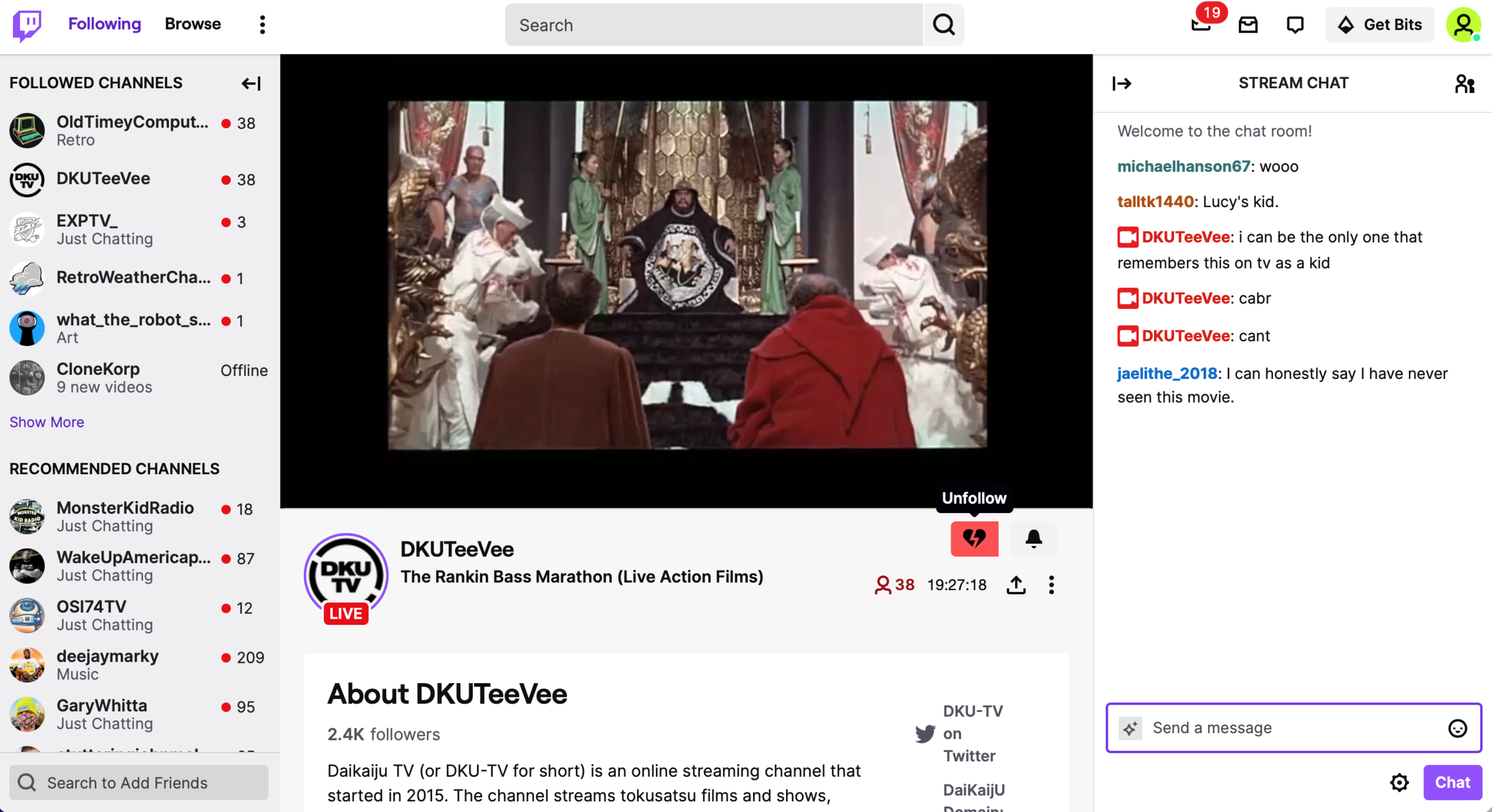
Twitch’s interface featuring the film Marco a 1973 American-Japanese historical musical adventure film directed by Seymour Robbie and starring Desi Arnaz Jr., Jack Weston and Zero Mostel.
How did It come to this? Pirate TV on Twitch.
I began January 2020 not on-line, instead far from it, painting in the dead of night, on broken concrete at the forbidden Sunken City in San Pedro CA, USA. I was dripping paint out of dishwashing liquid plastic bottles to make large, loose paintings with vertically aligned nearly unreadable text for a future fiction story I wrote about savagery in the coming post-apocalypse. A filmmaker stumbled upon me on night, covered in paint, dressed in black. His interest was piqued by my post-apocalyptic interest. He asked, “How do you think the world is going to end? Nuclear war and climate disasters?” I said to the camera, “I think it will be something we never see coming, like a virus.” The filmmaker replied, “Did you see the film, Contagion?” By February of 2020 the Covid-19 contagion was upon us. Could we contain it? The answer was, “No.” I spent 2020-22 stuck in a small beach apartment, all day every day in the lockdown.
Badly Licked Bear exists as a text and is also human. A rare human. Bear was the hero of my fictional, post-apocalyptical tale. It was Bear who implored his followers on social media to tune into a broadcast on Tuesday evenings titled, Museum of Home Video on something called Twitch. I’d never heard of the gamer’s platform before. Bear, written, “WATCH IT” convinced to check it out. What other choice did I have, alone in my apartment, locked out of the world?
Bret Berg, our host and programmer at Museum of Home Video, is a smart, handsome dude with gorgeous flowing hair, behind thin, rectangular glasses. He was smoking joint explaining the first clip I was about to view. Bret spliced together an exciting, funny 15 minutes out of the first day’s broadcast of The Weather Channel, from a slightly worn VHS tape on May 2, 1982. It was mesmerizing. Far from honed, broadcast from a hotel banquet hall, complete with a buffet table. The excitement of the speakers that day, was in sharp contrast to the dull banality of the content. Bret cut to a montage of video; I had no idea what I was watching. The montage was tied together with a bass heavy, slowed down version of some song: it was Vaporwave: hypnotic, and calming music for the digital dystopia. The Vaporwave vibe always strikes me as wandering in a warm shopping mall, shielded from a cold winter with a belly full of OxyContin. It ended with the Museum of Home Video logo on my screen. I was hooked.
The chat on Museum of Home Video is roiling and rollicking fun. The worse the material, or as Bret says, “the more mediocre,” the more the chat bubbled with smart-assed remarks. I joined in. It was like being part of a Mystery Science Theater 3000 episode. I was Tom Servo with a bunch of Joel Robinsons trapped on the Earth-orbiting, Satellite of Love, forced to watch a series of B movies with faceless, text multiples of Crow T. Robots and Gypsy robots. The show rolled on to an epic group street dancing and end credits to the film, Apple Pie (1975), in which Hall and Oates made an instrumental funk-disco jam that blew my mind (why won’t Hall and Oates take credit for this score? Why can’t I find it anywhere? Is the movie THAT bad? Yes. Yes, it is).
Then came one of Bret’s finest inventions, Fasterpiece Theater. A fifteen-minute montage of a bad film, like unwatchable bad. I saw the best of Skeeter, a 1993 horror film starring giant killer mosquitos and terrible acting. Bret effectively cut the watchable parts out to make a film that is somewhat decipherable with a few really funny edits, highlighting bad dialogue with poor conceptual story-telling devices. The chat becomes the other participant on the screen split with the stream. for two hours I was completely engrossed. Advertising dreams for that type of media attention: total, watching, listening, typing—I was all in, WITH it. I couldn’t wait to do it again.
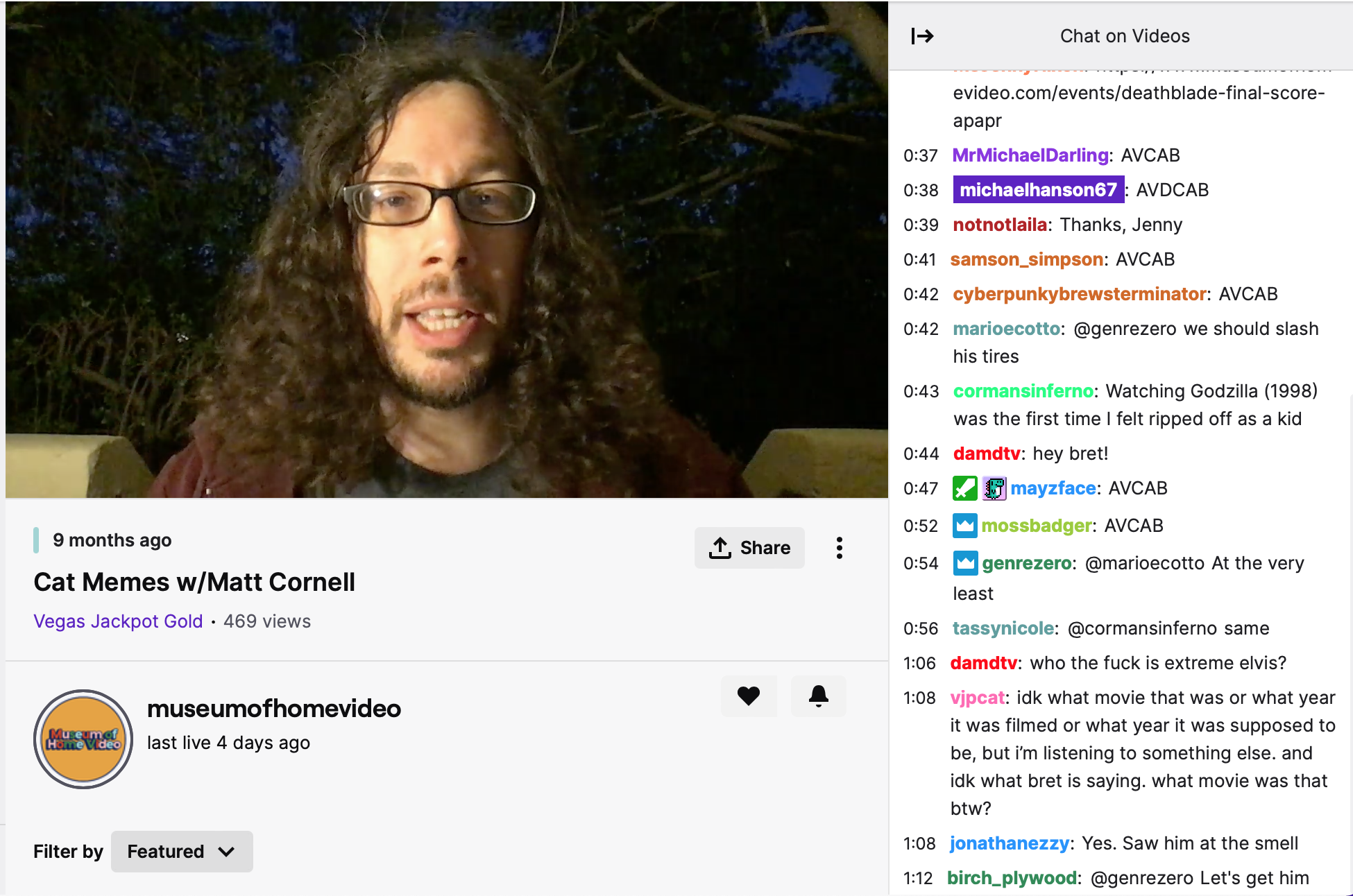
Bret is the Rod Serling of clip introduction but way less uptight.
Bret says pirate TV makes up 1/100th of 1% of Twitch but it was my niche, my 100th of that one percent. Pirate TV has a long history of shared VHS tapes and fragmented media repurposed usually shown on cable access or sold on VHS tapes, like Concrete TV. Bret credits, the clip montage show, Everything is Terrible as the direct forefather of MOHV. On Twitch during the pandemic, MoviePassed and Spectacle NYC appear to be the models for streaming pirate TV. When the pandemic shut down the art theaters they went to Twitch for their broadcasts, making great use out of the chat function. I made friends on MOHV with text-people using mysterious names like Fort90, CormansInferno, Otterdrugs and Mossbadger. Bodiless, voiceless but still human contact with genuinely insightful, smart, and funny commentary. I felt connected to them as we all were cut off from our regular lives in 2020. My new chat friend are the journalists, film buffs and arthouse film people from across the world that I would never meet in real life. People used to go into theaters for somewhat of an isolated experience. On Twitch, I was conversing with people seated in the front of the theater, the back and buying popcorn at concessions all at once. The only human contact afforded to me in the pandemic gave me hope. We suffered together, we laughed and cried on pirate TV via Twitch. We all found each other in that 1/100th of 1%.
Badly Licked Bear messaged me in July of 2020, it was urgent that I tune into Cathode TV, there was a Japanese Science Fiction marathon. Bear said the chat was more cinephiles and less jokey than MOHV but it was worth checking out. Was it ever! I was watching genres of film on Cathode I didn’t even know existed, like No Wave films from 1980’s New York, that captured the nihilistic feelings I harbored trapped in my tiny apartment. From two years of Twitch TV, I’ve consumed an MFA’s worth of film media. I branched out to other streams; on missmollyrogers I saw The Beach Bum, a 2019 American stoner comedy film written and directed by Harmony Korine and starring Matthew McConaughey. The plot follows the adventures of stoner poet Moondog (McConaughey) in and around the Florida Keys as he tries to finish his new novel for the respect of his daughter and his share of his wife's estate. The film was a box office disaster. Why? The film is beautiful genius about the struggle to write, to be true to yourself and your creativity. More astounding to me, I became a Matthew McConaughey fan, glued to every word, every bong rip. At the same time sharing my delight with my friends in chat. That same week on SickoVision, a stream from Australia, I saw The Bad Lieutenant: Port of Call - New Orleans and became a Nicolas Cage fan. Now mind you, I’m a huge Werner Herzog buff, every semester I show, Aguirre: The Wrath of God to freshman in my Humanities class but I always blew off The Bad Lieutenant because of well…you know: Nic Cage. Boy, was I wrong. I learned to laugh with my friends on chat through the Nic Cage film block. We mocked his over-acting in The Wicker Manas everyone in chat throughout the film typed, “Not the Bees!” “Bees!” to eventually just “B!” Pirate TV was my best friend during the pandemic, and I will forever be grateful for that.

The Wicker Man is a 2006 horror film written and directed by Neil LaBute and starring Nicolas Cage.
Then I found art on Twitch, not the art Twitch’s corporate statement touts but art in the form of a pirate TV stream known as RacerTrash. Like so many beautiful internet creations, RacerTrash started off as a joke. Film editor Alex T. Jacobs caught a double feature of Two-Lane Blacktop and Speed Racer on Ariel Gardner’s Twitch stream. He typed in chat that he’d always wanted a vaporwave cut of Speed Racer, but that it would probably never happen. Forty-eight hours later, on Jacobs’ birthday, his wish came true in the form ofSpeed Vapor, the first Racer Trash movie.
He and Gardner were in a group chat for filmmakers, mostly friends from industry circles in LA, who had gathered around the communal streaming hearth to watch movies in the pandemic. Jacobs’ dream idea quickly struck a chord with the group. Jake Robinson suggested dividing up the film and assigning segments (or “segs,” in racer-speak) to different people; several friends had worked on the 2014 movie Our Robocop Remake, where dozens of filmmakers reproduced parts of the original Robocop and assembled them into a single, maniacal feature.
And so, a new film collective was born, fueled by a distinctly punk ethos: to attack and dethrone cinema. One way to describe it might be movie graffiti. But depending who you ask, RacerTrash is also a powerful “fuck you” to capitalism and a nourishing refuge from regular editing work. There’s only one way to watchRacerTrash movies: live on Twitch.(1)
RacerTrash plays like a psychedelic dream. Using all the filters and effects that are available on editing programs in each scene. Everything drifts and melts. Dialogue is repeated over and over, rendered meaningless and simultaneously more meaningful in flited psychedelic bubbles. Other films sneak in into each film unexpectedly for a moment, juxtaposed on top of and underneath the title film. Don’t expect to understand the plot if you’re not familiar with the film the only plot is the moment you live in now. Right now—as if you are under a head full of codeine, hues mashing, glitching, dancing poetically—media churning. The sounds of Vaporwave mashing, grinding, holding onto each second, slower and slower. I didn’t know what to think other than, “This is art.”
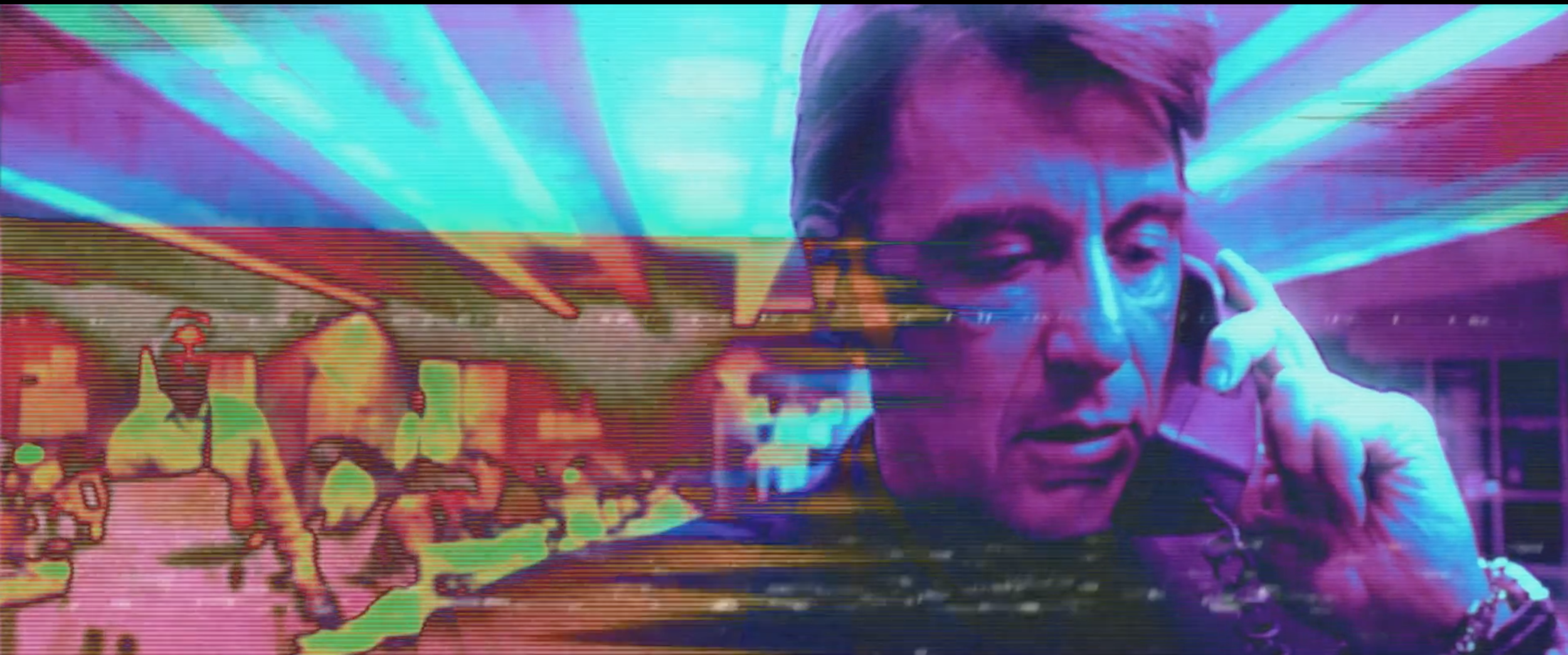
RacerTrash’s Heatwave (their take on Michael Mann's Heat, a 1995 American crime drama).
Wonderville NYC’s Fort 90 is my guide to understanding Twitch.
Twitch is an American video live streaming service that focuses on video game live streaming, including broadcasts of esports competitions, in addition to offering music broadcasts, creative content, and "in real life" streams. It is operated by Twitch Interactive, a subsidiary of Amazon.com, Inc. It was introduced in June 2011 as a spin-off of the general interest streaming platform Justin.tv. Content on the site can be viewed either live or via video on demand. That vibe still exists today, sleep streamer Asian Andy made $16,000 one night on his Twitch livestream. Andy set up text-to-speech recognition for his livestream and music played with every donation while the messages were read aloud. A lot of viewers used their messages to get Alexa to play loud music, imitate a dog barking, or make his alarm clock go off. Needless to say Andy didn’t get much sleep.
The journal article World of Streaming: Motivation and Gratification on Twitch reported the results of a Twitch user survey in 2017. In ranking user motivations on the use of Twitch, users were motivated (in descending order) to watch Twitch: "to be entertained,” "to follow gaming events” and to "have an alternative for television.” Motivations classified as "socialization" and "information" ranked lower than motivations classified as "entertainment.(2) The entertainment part is why I tuned in initially, the socialization part is a major reason I keep coming back. I’m not a gamer, which it seems to me so much of the content on Twitch is sharing gaming streams. I generally don’t watch people sleeping or doing chores as a stream. I also probably wouldn’t check out women in bathing suits standing in wading pools—all asking for donations to keep their streams running, or more specifically to keep the streamers paying rent and eating. Twitch allows anyone to watch a live broadcast and does not require viewers to log in. Users also have the option to follow and subscribe (also known as subbing) to streamers. Following is a free option, similar to other platforms such as Instagram and Twitter, where the user will see their followed streamers on the front page of Twitch when signed in and can receive notifications of specific broadcasts. Subscribing is a way for users to financially support streamers in exchange for exclusive benefits determined by the individual streamer.(3)
The direction of this show I intuitively knew, couldn’t be guided by only pirate TV. I needed an expert on gaming and Twitch, and I found him. It was a conversation on Zoom with Matthew Hawkins (Fort90) that this show in the gallery came together. I knew Matt for months as the smart, encyclopedic text-chat partner, Fort90 on the pirate TV streams I frequented. Matt invited me to his stream on Monday evenings at Wonderville abar and Twitch site in NYC. The first content I saw curated by Matt was Double Suicide: Japanese Summer, a 1967 Japanese film directed by Nagisa Ōshima. It’s absolute nihilism and Baroque tenebrism in every scene was film that I needed in 2020, stuck in my apartment 22 hours a day for months. Matt introduced me to so many things, a favorite being Zenjo (Japanese women’s wrestling). Matt is a top-notch archivist, his knowledge of the weird margins of culture is unparalleled. One night on WondervilleNYC we saw several videos from Japanese city pop musician, Mariya Takeuchi with crisp video from 30 years ago of random students at UCLA. Walking the campus, carrying color coded bags full of books from the bookstore. Young people doing the kind of stuff the campus probably shows in milquetoast orientation videos. It was a real outsider viewing the USA as a bland, happy, wholesome utopia. One of her videos toured us down Hollywood Boulevard; all happy tourism, not a sign of filth, grifters or errant feces. Where did this grand music video play? On TV? Yes and no. It wasn’t broadcast on a station but used in Japan in electronic stores selling TV’s. Wholesome California sun and students with a happy pop music, so positive it was almost demented. Matt Hawkins has backgrounds as a cartoonist, game developer and a journalist with a master’s degree in archival practices, a man of many talents and exquisite taste. Matt described three artists on Twitch to me in our Zoom call, all three of them are in this exhibit: Dandi Does It, The Sushi Dragon and What the Robot Saw. The performance art on Twitch, makes up the lion’s share of this exhibition. Does it count as performance art if it doesn’t know it’s performance art or have a strong catalogue of highbrow performance art knowledge (I mention this in relation to The Sushi Dragon)? I say yes here.
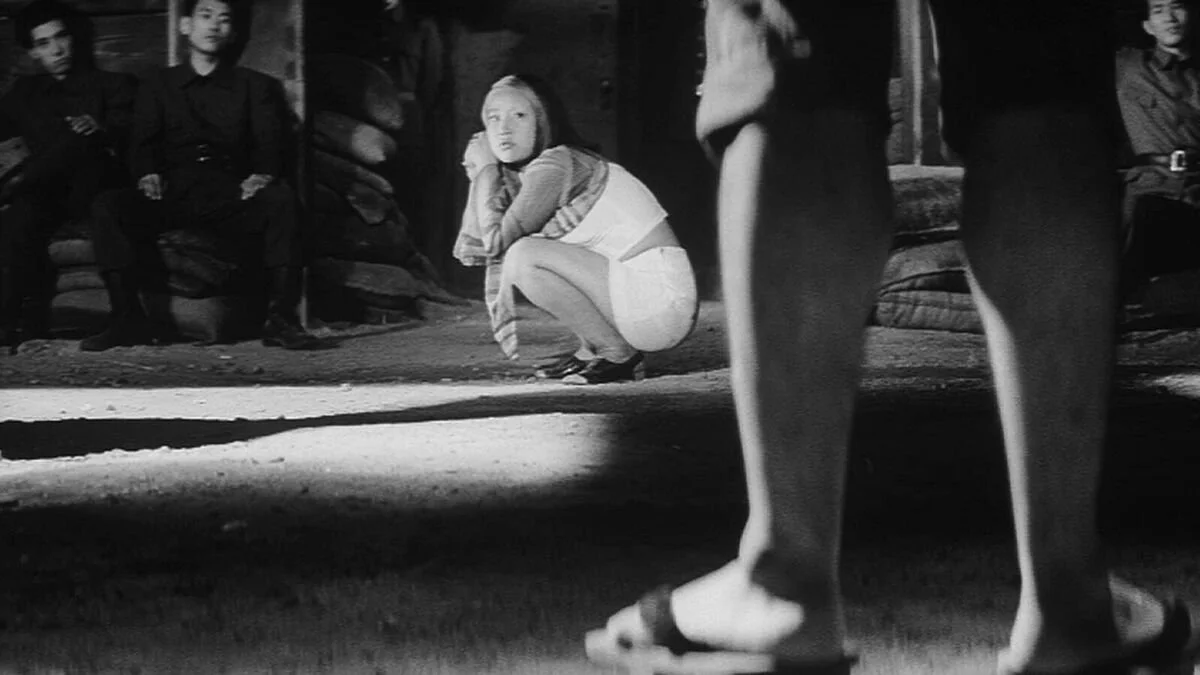
Double Suicide: Japanese Summer is a 1967 Japanese film directed by Nagisa Ōshima. Starring Keiko Sakurai as Nejiko
Performing and performance art on Twitch.
Besides gaming, live music and dancing rule the Twitch universe. I write this perhaps because I love seeing people in the ecstatic throes of joy. Twitch is way for many DJ’s and musicians to play in front of an audience without needing a venue. LuminanceMusic is a trance producer and DJ living in California for example. She works in esports as a manager and as a video editor. Her games of choice are Overwatch and World of Warcraft. She had no experience in mixing or preforming until the pandemic. She performed in her bedroom, mixing, grooving and interacting with her chat audience in real time. She’s moved from isolated performances in front of a virtual crowd to live venues. Going from the gaming world of Twitch into the live performing world makes sense as a progression. This is also the true for The Sushi Dragon.
The Sushi Dragon is best known for his dancing, which began when he would dance after winning in the video game Overwatch. Stefan reasoned, why not do a broadcast where the high energy mark of that victory dance is the whole stream? The fast twitch muscles used in gaming, are the natural, neural aspects in the gaming world on Twitch. It makes sense that a performer who is fully articulated from growing up in the gaming world becomes a programmer who wants to fast twitch through streaming. The Sushi Dragon’s performances are like watching a wasp trapped in a bottle, bouncing off the glass maniacally. The Sushi Dragon’s computerized exoskeleton is reminiscent of the Australian performance artist Stelarc, who programmed a pneumatic spider-like six-legged walking machine in 1997.

Stelarc, Exoskeleton 1997.
Stelarc looks like an arthritic dinosaur in his suit compared to The Sushi Dragon who is nimble, transforming moment to moment into face swapping and body swapping avatars as fast as he can push the activation buttons on the Twiddles he wears on his hands. The Sushi Dragon is adorned in a suit controlled by a “magical” computer backpack. His chest features a screen, which features the screed of the chat on his chest. He wears a digital eyepiece reminiscent of Mad Max films. He challenges the equipment to keep up with his fast-moving mind. His tropes and effects are all recognizable from anime and gaming spheres and mix without need for logical or careful transitions. He innovates camera angles on motorized equipment, that makes it look like he has an extensive camera crew, but he doesn’t, he is a one man show and crew. Everything in Sushi’s world is sped up to the breaking point. One sensation after another, each one exquisite and obtuse from the previous effect. The edge of human response time and computational power, it’s overwhelming. One just sits back and experiences him. His ADHD is a superpower in this world.
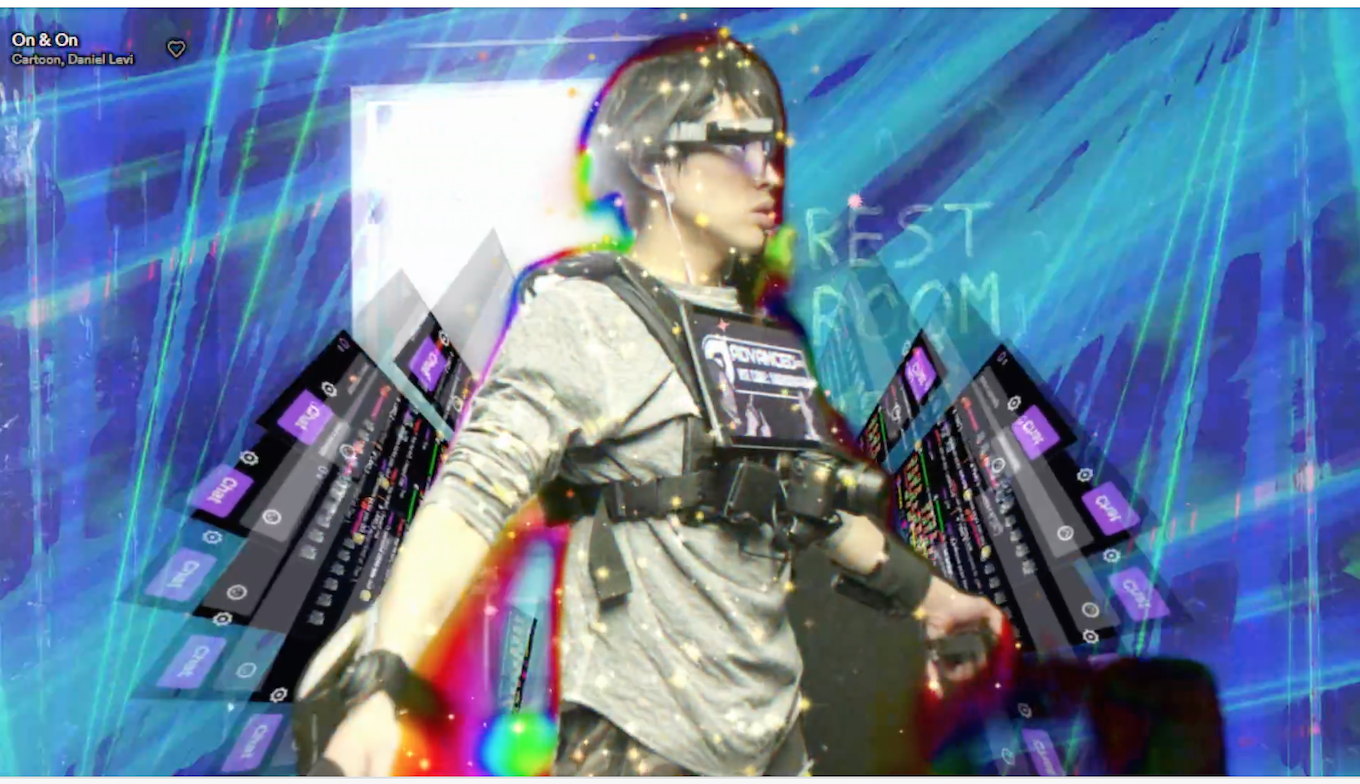
The Sushi Dragon 2022
Dandi Wind Opaine was a great Vancouver indie-musician who put on live shows that combined electroclash, no-wave punk, surrealist cabaret, and modern dance. Several years ago she moved to Toronto and teamed up with programmer, designer and great character voice actor, Matija Erceg. Dandi Does It is a spectacle of the highest degree. Warm and inviting, the stream makes you feel good—full of Pep, Positivity and Playfulness. The 3D graphic world Dandi inhabits in front of a green screen has blobby forms that chat users can inhabit in her wellness morning programs. There is a friendly floating computer and other organic life including friendly polar bears. This is a fully fleshed out and well written script with really dark dystopian undertones in a fully realized, valued and strategized world of the future. Dandi is modeled as a clone in each episode and the stream uses chat and subscribers to run her through tests to see if she is fit for mass production. In this world of science fiction I see where i.Mirror by Cao Fei took us in 2007 but Dandi is interactive and responsive. We are not just playing in a video game with animated avatars anymore.
Matija Erceg calls the stream a Live Performance Video Game. An LPVG is a livestream of a performer in a fictitious XR (Extended Reality refers to all real-and-virtual environments generated by computer technology and wearables) or AR (Augmented Reality is an overlay of computer generated content on the real world that can superficially interact with the environment in real-time) gamespace, where all its viewers have an interface to interact with the gaming elements of the gamespace and the performer(s) therein. (4)

Dandi in a fully interactive 3D environment.
The year is 3021, faster than light travel is possible, and other species in the local cluster of galaxies now mingle. Capitalism is alive and well, and The Company has basically acquired all other companies. One of The Company's branches deals with the production of clones, called 'Offsets', and The Dandi Line of Offsets is one such project. The Twitch users roleplay a sometimes-ambiguous role in the fiction, but most of the time they are Quality Assurance testers for the Dandi Line, and they observe each iteration of Dandi, and pass or fail it based on their performance. Passed Dandis go off-world to their destiny. Failed Dandis are decommissioned. A future where People are products. Company employees having control over Dandi's fate and body.(4) This mixture of Dandi’s purity and likeability and the possibility that the audience can destroy her—and do, makes a complexity to Dandi Does It that keeps me coming back to her streams for new episodes, not just the new 3D environments and new Company storylines.
Control over one’s own body is a central concept to consider when appreciating drag performances. Drag bars and queer performance spaces, shut down during the pandemic re-emerged on-line in 2020. Out of San Francisco, Media Meltdown is a queer celebration of cult media, weirdo pop culture, and childhood nostalgia hosted by drag performers and “roommates” (in the Biblical sense) Franzia Kafka and Piranha. Their main monthly drag show, every third Sunday offers a full evening of curated drag performance celebrating some of the zaniest media known to queerkind. They also screen films live with the hosts with surprise drag performances. (5) One of my favorites of their themed shows is titled, Nic Cage vs Jeff Goldblum. To view Media Meltdown is to be prepared for a body that can be anything, and I mean anything. Franzia and Piranha are masters of drag sensuality, and campy humor. Piranha has a long history of live performances and Franzia is the programmer and master set and costume designer.

Piranha in black stripes and Franzia as a purple zoomorphic bunny. (photo: Emily Ophidian)
Piranha talks of the difference between performing live and on Twitch, live there are butterflies. Not so much On Twitch. They are very comfortable in their feed banter, hosting and responding to the chat. Many streams have chat moderators to so the performers can concentrate on their performances. Franzia Kafka and Piranha seamlessly switch roles. I love when they become different species altogether, like when they became kittens bantering and sassing in a cute back and forth. One of the great streams is when Franzia became a living hot dog for their birthday broadcast. They always strike me as science fiction characters—people of the future, who can morph into anything; they are animal, mineral, fantasy and of course celebrity impersonators on any given broadcast: ANYTHING can happen. Living the last few years in a world that, I guess understandably, takes itself so seriously, in my book camp will always be a welcome respite from standard broadcast media blandness.
I was surviving the lockdown of 2020, maybe even having some good times, which I feel guilty even suggesting. Bret Berg is not only the MC and creator of his own show he also has excellent curatorial choices for other shows on his feed. Friday nights in 2020 I became enchanted with a performer on Museum of Home Video who goes by IVOR (the international voice of reason). His stream, Music Videodrome, the name which suggests an alignment to the 1983 film Videodrome, a Canadian science fiction body horror film written and directed by David Cronenberg. Set in Toronto during the early 1980s, follows the CEO of a small UHF television station who stumbles upon a broadcast signal featuring violence and torture. Was I about to be tortured? By music videos? I was certainly open to anything in 2020 but no, I was about to be delighted by music videos, artful crafted by a veteran of LA college radio. I would say IVOR is the one who is tortured, by his own self, appearing to be completely uncomfortable in front of the camera. Ivor hides under wigs and shiny white suits as he stammers, swears and groans through his show. He’s drinking, drunken, hilarious (intentionally and unintentionally) in his stream and has a honed, great queer ear for the music he curates. I was an instant fan. He is the artist who made me begin to think about performance art on Twitch. Why weren’t there more artists, more streamers doing this? The funny thing is for two years I’ve been raving about it and everyone not on Twitch has no idea what I’m talking about.

IVOR (the international voice of reason)— ps it’s music and booze.
Programming on Twitch. What robots see in you.
Programming has two distinct meanings in this context. The first one is the computer programmer, a world of hardware, software and codes. The second kind of programming is the curation, often referred to in the world of TV as programming. Bret Berg spends days cutting clips, from acquired media; then screening and condensing to produce shows for Museum of Home Video. Bret and other pirate TV streamers often use software ranging from common entertainment industry editing software to OBS (Open Broadcaster Software) a free software to stream their shows. I would argue the first kind of programming is essential, a beginning point of process to make any of the streams the artists present in this exhibition. First you must program, then you can perform, after which we as the audience can participate. What the Robot Saw is a type of performance based on programming. Humans perform but the robot is the star omnipotent who organizes, it all.
What the Robot Saw is a constant stream once on YouTube until their bots kicked off her screening bot. Now on Twitch, this AI performance is programmed by Amy J Alexander, an artist and UCSD computer art faculty member. ‘What the Robot Saw’ is a live, continuously-generated, robot film, curated, analyzed and edited using computer vision, neural networks, and contrarian search algorithms. It highlights some of the least viewed videos on YouTube, featuring first person narratives by people commercial ranking algorithms generally rendered invisible.(6)
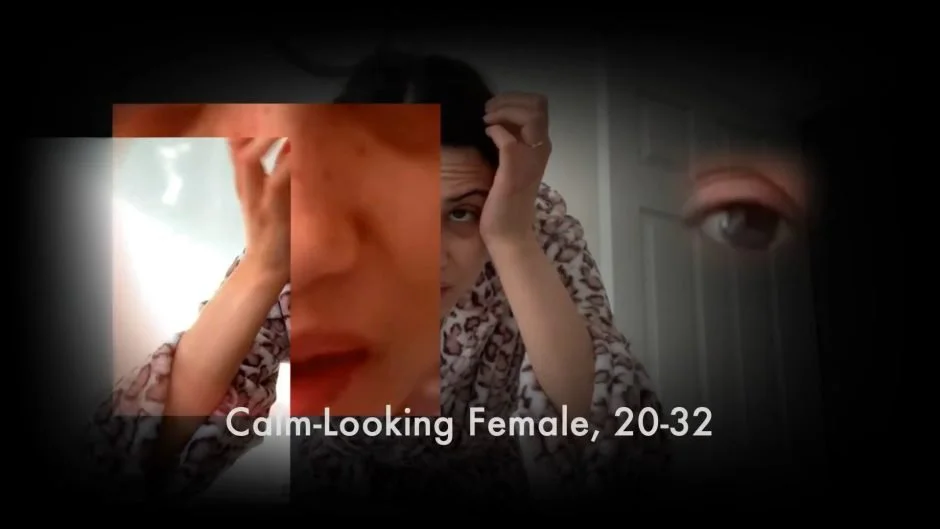
What the Robot Saw: Calm-looking female, 30-32
Amy programs the algorithms with Python (a high-level general-purpose programming language emphasizing an object-oriented approach) project and the visuals through MaxMSP (a visual programming language for music and multimedia). The final effect is dazzling. Partial images of faces, especially eyes move within repositioning rectangles which disappear when new images reappear. The program is deciding who to look in on how to do so, leaving the viewer feeling like a voyeur peeking through undefinable doorways. Always peeking never revealing the whole. Every person is knowable as data to the program never to the viewer. We are seeing what the bot sees, maybe more accurately what the bot allows us to see. Amy’s website says, “The Robot adds lower third supered titles. Occasional vaguely poetic section titles are derived from the Robot’s image recognition-based groupings. More often, lower-third supers identify the many “talking heads” who appear in the film. The identifiers – labels like “Confused-Looking Female, age 22-34” – are generated using Amazon Rekognition, a popular commercial face recognition and analysis library.” (7)
Each screenshot of the action could be great painting filled with human intrigue invoking a type of pathos seeing those who desire to be seen but rarely are except in this case through the eyes of a bot. “The feature set of Rekognition offers a glimpse into how computer vision robots, marketers, and others drawn to off-the-shelf face analysis products often choose to categorize humans: age, gender, and appearance of emotion are key. The prominence of these software features suggests that in a robot-centric world, these attributes might better identify us than our names.”(6) We are all data ready to parse into categories for what purposes? What I’m most concerned about is how does this information get misused especially when the Robot seems to mis-classify thing so often.
I recognize spending an essay going into the ins and outs of software has a very short shelf life of relevance. Yet, for the pandemic years of 2020-22 there are a couple of programs that seem really important to pirate TV and Live Performance Video Games streams on Twitch. For streamers engaged with showing old and obscure films is the software, Open Broadcaster a free, open-source, and cross-platform screencasting and streaming app. Available for Windows and macOS, OBS Studio provides real-time capture, scene composition, recording, encoding, and broadcasting via the Real Time Messaging Protocol (RTMP). It can stream videos to any RTMP-supporting destination, including YouTube, Twitch, Instagram and Facebook. The main user interface is organized into five sections: scenes, sources, audio mixer, transitions, and controls. Scenes are groups of sources like live and recorded video, text, and audio. OBS seems to be the go-to because of its simple interface but mainly because of its accessibility because it’s free.

Dandi Does It home studio 2021.
It seems TouchDesigner transformed Dandi Does It and Sushi Dragon’s streams into a smooth response network of 3D animation graphics and Live performing. TouchDesigner is described as, a “visual programming environment aimed at the creation of multimedia applications. There are many tools for what we call today “Creative Coding”. The main idea is, that programming should be accessible for artists and designers also without a formal programming education. There are different approaches to achieve this and one of the most popular ones is called “Visual Programming”. Visual programming is a type of programming language that lets humans describe processes using graphic instead of text-based metaphors, and indeed visual programming has opened the door to interactivity for many creatives that never got into text-based coding.” TouchDesigner connects “everything to everything” in the digital media world.(8)
Dandi Does It’s Matija Erceg discusses his move from OBS to TouchDesigner, “With OBS, we had to push it past its comfort zone, and anything 3D was just asking for pain. With TD, if something's not running well, it's more likely just something that needs a bit of optimization. With OBS, I'd often think about how 'I wish I could do that, but alas.", and with Touch I often think "I love this program.” I’m able to think more about the concept than the tool. I feel more playful inside of Touch because nothing has to be baked in, everything is real-time and parametric, which makes it easier to 'jam out'. With OBS, I had to have a clear and concise goal, and then twist its arm to get it to do that, often with plugins. In short, we do 90% of everything in TouchDesigner now (2021), whereas last year (2020) we did 90% of everything in OBS.”(9)
Participating on Twitch: the active viewer.
Real time interactions with the streamers is the secret sauce of Twitch broadcasts that makes Twitch more engaging than normal network TV in my opinion. Five seconds after I entered the stream of CloneKorp, on the recommendation of Dandilion, I was confronted, in the best way possible by the host, “Who sent you here?!” I replied immediately and he was delighted to know it was Dandilion. Then he continued with his stream of consciousness broadcast. The user participation is a designed part of the Twitch world. Twitch allows anyone to watch a live broadcast and does not require viewers to log in. Users also have the option to follow and subscribe (also known as subbing) to streamers. Subscribing is a way for users to financially support streamers in exchange for exclusive benefits determined by the individual streamer.
Bret Berg has described the chat on Museum of Home Video as a central feature. MOHV has a loyal following of familiar names who joke and support each other in nearly every broadcast. It was a bit unusual, as many of the streams outside of pirate TV have a shorter attention span. The movie and TV crowd is more likely to stay for whole segments on Twitch than performing streams. Also, many of the chat members who participate on MOHV do so regularly even though the percentage of those who watch and participate seems to be fairly low. During the broadcasts Bret will respond to questions about the segments and laugh when something strikes his funny bone. The moderator on MOHV, Ms. Jenny Nixon fosters conversation, humor, and friendly interaction throughout the broadcast. After viewing many hours of MOHV, I’m struck that there is no trolling, no mean-spirited banter at all. For anything on-line with a few hundred participants that seems like an impressive feat. Positive vibes everywhere on a Twitch seems like a real public service during the gloom of the pandemic. Especially because the gaming streams are full of weird dude energy, competitive spite, and outright vitriol.
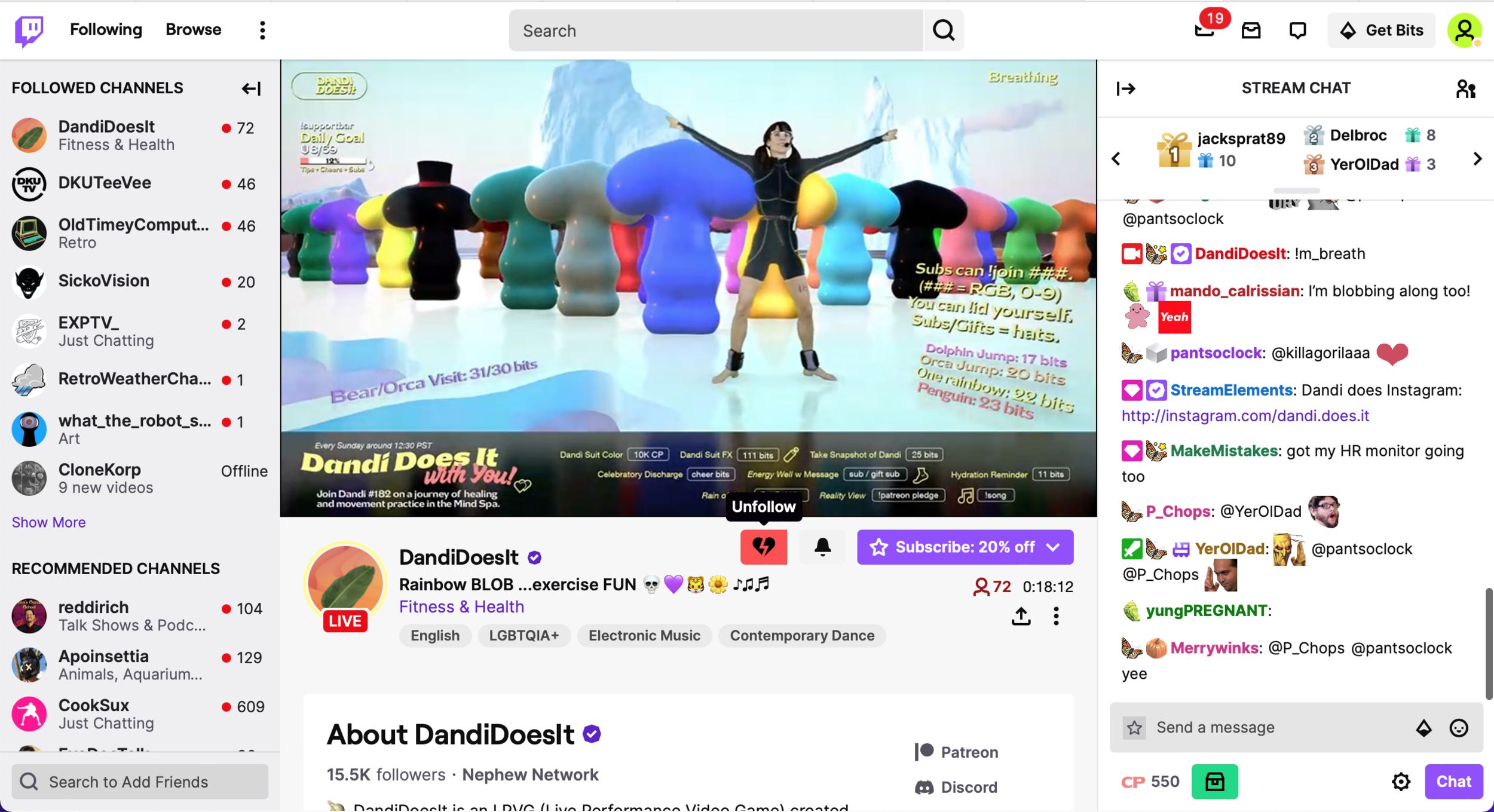
Working out as blobs with Dandi on her wellness program.
Dandi Does It, Media Meltdown and The Sushi Dragon all use their chat and subs in inventive ways outside of commentary and bater. Subbing gets the viewer special access to emojis and other perks; On Dandi Does Its workout-wellness show subbing means you can work out as a blob with a top hat or have penguins to wander into the fray. Media Meltdown plays games like bingo and takes polls with the chat. In an interview, The Sushi Dragon described his chat audience as a collective consciousness. A very interesting observation from the performer who literally wears a screen with the chat on his chest. What his comment struck me as, was someone who viewed all the voices as a single entity with many arms, moving together but acting independently. The Sushi Dragon credits his chat with helping him to program his stream, as collaborators not simply viewers. In fact, he said he didn’t know anything about programming and his chat members were instrumental in his developing his extensive technical set up. A The Sushi Dragon broadcast uses several camera angles to create the illusion of more than a one-person crew at work; all made by hacking into other motorized vehicles, several servers, and an ever-increasing list of software, Voicemeeter, Voiceattack, OSCPilot, Chataigne, (which is the newest software that organizes all his computers—the only program that can withstand his performances without crashing) and of course OBS and TouchDesigner.
Futureworld. Forecasting the future: Twitch and the artists.
The future of pirate TV on Twitch seems tenuous at best. Eventually the fact the streamers don’t own the rights to what they’re streaming will be a death knell to the activity. Will that be tomorrow or in a few years is anybody’s guess. Twitch does monitor everything. They mute music the streamers don’t own, they suspend broadcasts that break rules for wearing revealing clothing. So, it makes sense that eventually they’ll suspend the pirate streamer, but only when they get pressure from lawyers representing the owners of the pirated subject matter. Personally, it seems to me the streamers are showing content that is so obscure or out of popular favor they’re simply advertising things that might be totally forgotten; through the broadcasts the owners might find new consumers. The smart money says the first streamers to go are those who are making money on the streams with paid advertisements. I suspect keeping on the downlow and trying to fund the streams from outside benefactors on Patreon is the smart move. Make no mistake though, pirate TV will be here, it will move locations and mediums, but it is here to stay. There are consumers who desire it and there are dedicated cinephiles to keep it alive.
Twitch will eventually fall out of favor, or some fledgling media in the shadows will support gaming platforms better. It’s inevitable. The gaming share have been declining for a few years but for now it’s a Jeff Bezos funded speculative future. The Just Chatting feature designed for the performances and streams of the mundane is a good source for Twitch’s bottom line. I hope more artists and musicians and weirdos will continue to develop this part of Twitch. I’m still a bit surprised how few artists and broadcasters there are outside of the gaming sector. Make no mistake though the culture of Twitch is gaming and has all the problems and toxicity and fickleness of gamers, that may pull down the temple eventually. Gamers are very narrow in what games they’ll support and what they think is proper gaming culture. Gamers narrow rather than expand in their interests typically.
Museum of Home Video’s Brett Berg plans to continue with his pre-pandemic plan to program IRL at art house theaters across the USA. If I were a TV executive, I would hire him to enter my archives and continue his cultural detournement by cutting down the flops my networks have made, making them faster and funnier. If I were in advertising, I’d have Bret go into my commercial archives and have him cut together commercials like he did with the BoKu fruit-juice commercials with Richard Lewis. Brands that have a self-depreciating sense of humor can profit from that angle. Bret has a great eye for comedy. I think there are many commercial places for him if the executives “get it.” I think a network should give him a development deal and continue Museum of Home Video’s video clip format. I also suggest broadcasting the chat with the show; hold a contest for 20-30 regular, non-professional people in chat and slip in a few comedy writers as well. Broadcasting mediocre TV with funny commentary has a future outside of the obscure corners of the internet. Bret is influencing other editors to stream, following Bret’s urging that “everyone can be editors, it’s easy.” A new stream, Drek on Twitch hosts a clip show using concepts from MOHV like Fasterpiece Theater and Bret’s sense of pacing.
Dandi Does It, clearly should be made into a video game, where gamers could play the role of the live character Dandi. Dandilion Wind Opaine and Matija Erceg are natural performers. Dandi Does It is a fully formed place for serial TV like on AdultSwim or Netflix, I could also see the dystopic science-fiction aspect fleshed out into a feature length film, with a budget that allows for a few more ancillary characters. I could see Dandi Does It in its current form as a sci-fi yoga show for Generation Z. Dandi Does It is also something art museums shouldn’t sleep on as performance and video art, those vibes are present in its current iteration.
The Sushi Dragon is a superstar. He’s mesmerizing on screen. His early youtube videos from 2011 are very funny, with clever subversive ideas. Like when he dressed and played a woman on Chatoulette recording the reactions when he revealed his ruse. His use of the tech connected to his body with face swapping, glitches, fire breathing and victory dances, without purpose other than the moment is pure art to me. Handsome, wearing Vuzix smart glasses over one eye so he sees holographic projections of his computer displays, he’s become the equivalent of a Hindu god in constant transformation from one avatar to another; fluid reality that cannot stand still, hyper-human in rarified space for a flash of a moment. Sushi Dragon should be scooped up now as a talent for something big. Broadcast him, let him go. Give him a budget. His stream reminds me of Paul Reubens (Pee Wee Herman) in PeeWee’s Playhouse, he is both wholesome and naughty. Put some writers around him, let him star, or let him co-star. He is everything you want in media, he’s young, funny, hip, mesmerizing. Several brands already attached themselves to him, it’s current funding his streams out of a warehouse in Montana, I suspect more are coming—soon.

The Sushi Dragon 2022
Media Meltdown is working on original content in part because it’s hard to do a drag show without rights to the music, drag bars normally have some sort of licensing deal. Some executives of a network should see the potential of a drag, parody, variety show. Not in the margins of specialized queer stations but in the prime time, usual suspects of big broadcasting. Piranah and Franzetia have a classic comedy duo feel about them. Think forward, normalize their talents. Utilize the new digital video effects with Franzetia’s sense of fashion and set building. Drag has a bawdy, naughty, raucous quality that would make for a great 21st century Gong Show. I suspect though, coming from the world of live drag shows in San Francisco they will continue to use their talents by performing live in front of an audience—eye to eye. To a performer used to live theater TV usually feels stilted, drained of spontaneity. I hope they’ve increased their coolness quotient through their Twitch streams to gain bookings.
Amy J Alexander’s What the Robot Saw knows it’s art. It’s deep. It does what good art is supposed to do: it gives you a WTF moment then sticks to you. It’s eerie. You don’t spend hours with What the Robot Saw. It does what art does in galleries, you pause, you contemplate, and you move on. Viewing art in galleries and museums is like swiping on Tinder. Performed by the machine, watching us, making notations this project chills me. I consider how the bot is watching perhaps the most vulnerable, those who put themselves out on the internet and nobody, but the machine is there. What if the machine intercepts or influences them? How many machines watch you, weigh you for every possible thing you share digitally? How many bots influence your sense of yourself, of the world and your place in it? I would say keep an eye on Amy and her art, but her bots are probably already doing that.
Thank you to Janet Owen-Driggs for setting up this exhibition. Thank you to all the artists I’ve conversed and corresponded with over the last few months—you are the sweetest people and I wish you continued joy and success in your endeavors.
Footnotes
1. The Verge.com. Alexis Ong. Jun 30, 2021 https://www.theverge.com/22555946/racer-trash-punk-twitch-film-collective
2. Wikipedia, the free encyclopedia. https://en.wikipedia.org/wiki/Twitch_(service)
3. Wikipedia, the free encyclopedia. https://en.wikipedia.org/wiki/Twitch_(service)#Streamers
4. Derivative. TouchDesigner. Isabelle. Dandi Does It Again and Again and Again. Oct 28, 2021. https://derivative.ca/community-post/dandi-does-it-again-and-again-and-again/65087
5. Media Meltdown website. About us. https://www.mediameltdown.tv/about
6. What the Robot Saw website. Amy J Alexander. https://what-the-robot-saw.com
7. Ibid
8. The Node Institute. What is TouchDesigner and why should I use it? https://thenodeinstitute.org/courses/introduction-to-visual-programming-with-touchdesigner/lessons/what-is-touchdesigner-and-why-should-i-use-it/
9. Derivative. TouchDesigner. Isabelle. Dandi Does It Again and Again and Again. Oct 28, 2021. https://derivative.ca/community-post/dandi-does-it-again-and-again-and-again/65087